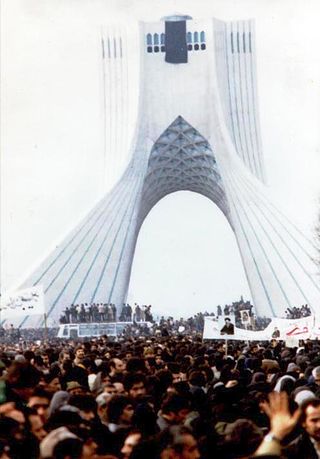
Ayatollah Ruhollah Musavi Khomeini was an Iranian Islamic revolutionary, politician, and religious leader who served as the first supreme leader of Iran from 1979 until his death in 1989. He was the founder of the Islamic Republic of Iran and the main leader of the Iranian Revolution, which overthrew Mohammad Reza Pahlavi and ended the Iranian monarchy.

The Iranian Revolution, also known as the 1979 Revolution and the Islamic Revolution, was a series of events that culminated in the overthrow of the Pahlavi dynasty in 1979. The revolution led to the replacement of the Imperial State of Iran by the present-day Islamic Republic of Iran, as the monarchical government of Mohammad Reza Pahlavi was superseded by the theocratic Ayatollah Ruhollah Khomeini, a religious cleric who had headed one of the rebel factions. The ousting of Pahlavi, the last Shah of Iran, formally marked the end of Iran's historical monarchy.

Seyyed Ali Hosseini Khamenei is an Iranian Twelver Shia marja' and politician who has served as the second supreme leader of Iran since 1989. He previously served as third president of Iran from 1981 to 1989. Khamenei is the longest-serving head of state in the Middle East, as well as the second-longest-serving Iranian leader of the last century, after Shah Mohammad Reza Pahlavi.

Ali Akbar Hashimi Bahramani Rafsanjani was an Iranian politician and writer who served as the fourth president of Iran from 1989 to 1997. One of the founding fathers of the Islamic Republic, Rafsanjani was the head of the Assembly of Experts from 2007 until 2011 when he decided not to nominate himself for the post. He was also the chairman of the Expediency Discernment Council.

Grand Ayatollah Hussein-Ali Montazeri was an Iranian Shia Islamic theologian, Islamic democracy advocate, writer and human rights activist. He was one of the leaders of the Iranian Revolution and one of the highest-ranking authorities in Shīʿite Islam. He was once the designated successor to the revolution's Supreme Leader, Ayatollah Khomeini, but they had a falling-out in 1989 over government policies that Montazeri claimed infringed on people's freedom and denied them their rights, especially after the 1988 mass execution of political prisoners. Montazeri spent his later years in Qom and remained politically influential in Iran, but was placed in house arrest in 1997 for questioning "the unaccountable rule exercised by the supreme leader", Ali Khamenei, who succeeded Khomeini in his stead. He was known as the most knowledgeable senior Islamic scholar in Iran and a grand marja of Shia Islam. Ayatollah Montazeri was said to be one of Khamenei's teachers.

Ali al-Husayni al-Sistani is an Iranian-Iraqi Islamic scholar. One of the most senior scholars of Twelver Shia with the rank of Grand Ayatollah and marja', he has been described as the spiritual leader of Shia Muslims worldwide, "the undisputed leader of Iraq's Shias", included in top positions of "The Muslim 500: The World's Most Influential Muslims", from 2009 to 2024, and named one of the 100 most influential people in the world by Time magazine in 2004 and 2005.
Special Clerical Court, or Special Court for Clerics is a special Iranian judicial system for prosecuting crimes, both ordinary and political, committed by Islamic clerics and scholars. The Special Clerical Court can defrock and disbar Islamic jurists, give sentences of imprisonment, corporal punishment, execution, etc. The court functions independently of the regular Iranian judicial framework, with its own security and prison systems, "generally secret and confidential" cases, proceedings and procedures, and is accountable only to the Supreme Leader of Iran,. The most senior Islamic politician to be prosecuted and sentenced to prison since the Iranian Revolution was Abdollah Nouri who was sentenced to five years in prison for political and religious dissent by the court in 1999.

Muhammad Taqi Misbah YazdiGiwachi was an Iranian Shia scholar, political theorist and philosopher who served as the spiritual leader of the Front of Islamic Revolution Stability.
Vilayat-e Faqih, is Persian for guardianship of Faqīh

Islamic Government, or Islamic Government: Jurist's Guardianship is a book by the Iranian Shi'i Muslim cleric, jurist and revolutionary, Ayatollah Ruhollah Khomeini. First published in 1970, it is perhaps the most influential document written in modern times in support of theocratic rule.
The Guardianship of the Islamic Jurist is a concept in Twelver Shia Islamic law which holds that until the reappearance of the "infallible Imam", at least some of the religious and social affairs of the Muslim world should be administered by righteous Shi'i jurists (Faqīh). The nature of these affairs are disputed.

Traditionally, the thought and practice of Islamic fundamentalism and Islamism in the nation of Iran has referred to various forms of Shi'i Islamic religious revivalism that seek a return to the original texts and the inspiration of the original believers of Islam. Issues of importance to the movement include the elimination of foreign, non-Islamic ideas and practices from Iran's society, economy and political system. It is often contrasted with other strains of Islamic thought, such as traditionalism, quietism and modernism. In Iran, Islamic fundamentalism and Islamism is primarily associated with the thought and practice of the leader of the Islamic Revolution and founder of the Islamic Republic of Iran, Ayatollah Ruhollah Khomeini ("Khomeinism"), but may also involve figures such as Fazlullah Nouri, Navvab Safavi, and successors of Khomeini.

One of the most dramatic changes in government in Iran's history was seen with the 1979 Iranian Revolution where Shah Mohammad Reza Pahlavi was overthrown and replaced by Ayatollah Ruhollah Khomeini. The authoritarian monarchy was replaced by a long-lasting Shiite Islamic republic based on the principle of guardianship of Islamic jurists,, where Shiite jurists serve as head of state and in many powerful governmental roles. A pro-Western, pro-American foreign policy was exchanged for one of "neither east nor west", said to rest on the three "pillars" of mandatory veil (hijab) for women, and opposition to the United States and Israel. A rapidly modernizing capitalist economy was replaced by a populist and Islamic economy and culture.

A constitutional referendum was held in Iran on 28 July 1989, alongside presidential elections. Approved by 97.6% of voters, it was the first and so far only time the Constitution of the Islamic Republic of Iran has been amended. It made several changes to articles 5, 107, 109, 111, and added article 176. It eliminated the need for the Supreme Leader (rahbar) of the country to be a marja or chosen by popular acclaim, it eliminated the post of prime minister, and it created a Supreme National Security Council.

This article is a timeline of events relevant to the Islamic Revolution in Iran. For earlier events refer to Pahlavi dynasty and for later ones refer to History of the Islamic Republic of Iran. This article doesn't include the reasons of the events and further information is available in Islamic revolution of Iran.
Grand Ayatollah Ahmad Azari-Qomi-Bigdeli was an Iranian cleric. Born in 1925 in Qom, after the 1979 Iranian Revolution he served on the Special Clerical Court, and Assembly of Experts, founded the conservative Resalat Newspaper. He was arrested in November 1997 after an open letter by him was published in Britain criticizing Supreme Leader Ali Khamenei for allowing torture and "moral corruption" among officials and clerics. Shortly after Khamenei denounced him in a televised speech for allegedly committing "treason against the people, the revolution and the country." His renewed candidacy for the Assembly of Experts was rejected by the Guardian Council the next year and he died in 1999.
Premiership of Mir-Hossein Mousavi were the third and fourth government of Iran after the Iranian Revolution. At that time, Ali Khamenei was the president.

The supreme leader of Iran ), also referred to as Supreme Leader of the Islamic Revolution, but officially called the Supreme Leadership Authority, is the head of state and the highest political and religious authority of the Islamic Republic of Iran. The armed forces, judiciary, state radio and television, and other key government organizations such as the Guardian Council and Expediency Discernment Council are subject to the Supreme Leader. According to the constitution, the Supreme Leader delineates the general policies of the Islamic Republic, supervising the legislature, the judiciary, and the executive branches. The current lifetime officeholder, Seyyed Ali Hosseini Khameneh known as Ali Khamenei, has issued decrees and made the final decisions on the economy, the environment, foreign policy, education, national planning, and other aspects of governance in Iran. Khamenei also makes the final decisions on the amount of transparency in elections, and has dismissed and reinstated presidential cabinet appointees. The Supreme Leader is legally considered "inviolable", with Iranians being routinely punished for questioning or insulting him.

The Execution of Imam Khomeini's Order (EIKO), also known as the Executive Headquarters of Imam's Directive or simply Setad, is a parastatal organization in the Islamic Republic of Iran, under direct control of the Supreme Leader of Iran. It was created from thousands of properties confiscated in the aftermath of the 1979 Islamic Revolution. A Reuters investigation found that the organization built "its empire on the systematic seizure of thousands of properties belonging to ordinary Iranians", also seizing property from members of religious minorities, business people and Iranians living abroad; at times falsely claiming that the properties were abandoned.

The Government of the Islamic Republic of Iran, known simply as Nezam, is the ruling state and current political system in Iran, in power since the Iranian Revolution and fall of the Pahlavi dynasty in 1979.
































